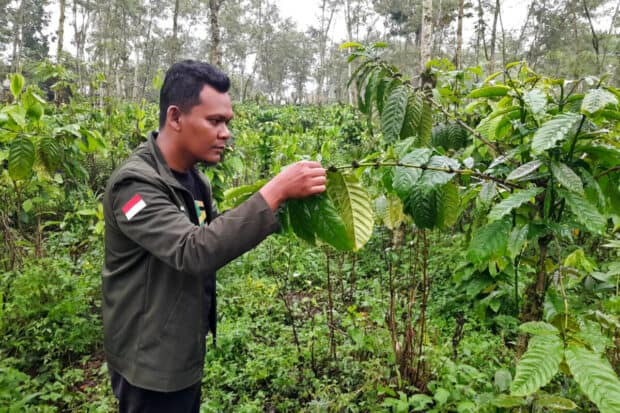[[{“value”:”
Indonesia is the world’s fourth-largest producer of coffee, after Brazil, Vietnam and Colombia, but the archipelago’s farmers are less productive than their competitors.
In East Java province, farmers have seen yields plummet as a protracted water deficit shrinks fruit and introduces pests.
Total output is expected to drop by more than 20% this season, while increasingly frequent extreme weather may pose challenges to the viability of some smallholders in lowland areas of Indonesia.
JEMBER, Indonesia — In good weather, Saturi’s coffee field here on a hillside on the east of Indonesia’s Java Island will produce around 2.5 metric tons of coffee beans over the course of a season. This year, he expects to get less than a ton.
“The weather has meant there have been a lot of fires,” Saturi told Mongabay Indonesia at his home in Jember district in December.
Saturi’s story reflects the plight of farmers more broadly in the world’s fourth-largest coffee-producing nation, where the weather has lurched from extreme rainfall caused by a La Niña climate pattern that lasted from 2020-2022, to a punishing drought sparked last year by El Niño.
This year’s coffee harvest in Indonesia is forecast to be the lowest in more than a decade. Jember farmers blame El Niño, in which above-average temperatures in the Pacific produce dangerously dry weather over Southeast Asia.
Torrential rain over a long period can easily drown coffee flowers before they produce beans, while sustained heat and a deficit of water typically stunt coffee flowers and dry up the tree’s leaves.
Indonesia recorded coffee output of almost 12 million 60-kilogram sacks during the season that spans 2022 and 2023, but total production in the current year is expected to plummet to less than 10 million as El Niño induces feverish temperatures across low-lying coffee areas.
Coffee farmer Saturi examining his coffee plants in Jember. Image by Moh Tamimi/ Mongabay Indonesia.
Extreme weather has brought challenges to a diverse basket of food crops around the world. Last year, prices of rice, a staple in Indonesia, surged due to a supply shortfall induced by drought. Rising food prices prompted President Joko Widodo to urgently second military personnel to pitch in with rice planting in December.
On an overcast day that same month, Saturi walked through his plantation dressed in funereal black to inspect the fruit on some of his 3,200 robusta coffee trees. At any other harvest time, Saturi would normally collect the beans three times, waiting up to three weeks between picks. But in December it was clear to Saturi that many flowers had not survived.
“When the coffee has gone bad, it’s hard to recover,” he said. “You have to replant.”
However, official data show that farmers have replanted only a handful of Indonesia’s estate of coffee trees in recent years, restricting their ability to boost yields.
Research has shown that the changing climate could reduce by 21–37% the land available for coffee cultivation in Indonesia, with similar declines in other parts of the globe.
Indonesia accounts for one of the world’s largest agricultural economies, but farmers in the country of 275 million people are already much less productive than neighboring countries like Vietnam, where coffee production is up to three times higher than in Indonesia.
Like many of Indonesia’s smallholder farmers, Saturi complains the government is doing too little to support coffee farmers, and that fertilizer is scarce.
“Even if you can get it, the price is expensive,” he said.
This year’s coffee harvest in Indonesia is forecast to be the lowest in more than a decade. Jember farmers blame El Niño. Image by Moh Tamimi/ Mongabay Indonesia.
Jember coffee farmers have tried diversifying by planting fast-growing papaya, but the trees suffer similar fates in the sweltering heat.
Pujianto, an expert at the Indonesian Coffee and Cocoa Research Center (Puslitkoka), said El Niño can have positive impacts in highland growing areas in Sumatra, but that consequences can be ruinous in lowland forests exposed to heat and drought.
“The impact of this decrease in rainfall will be quite significant on certain fields, especially the fields in the lowlands where there is either little shade or none at all,” he said, adding that up to a third of trees might fail this year.
Indonesia’s national meteorology agency, the BMKG, has forecast El Niño to continue well into 2024. That has coffee farmers in Jember worried. Saturi said he expects his harvest to be cut in half this year.
“The flowers are dry and a lot of the leaves have wilted,” Saturi said. “And the trees are dying because of this dry weather.”
Note: This article is republished from Mongabay under a Attribution-NoDerivatives 4.0 International (CC BY-ND 4.0) Creative Commons license. Read the original article here. Any statements or opinions expressed belong solely to the author/s and do not necessarily reflect the views of Daily Coffee News or its management.
“}]]


